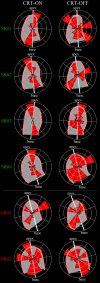Changes in electrical activation modify the orientation of left ventricular flow momentum: novel observations using echocardiographic particle image velocimetry
- PMID: 26060201
- PMCID: PMC4882880
- DOI: 10.1093/ehjci/jev137
Changes in electrical activation modify the orientation of left ventricular flow momentum: novel observations using echocardiographic particle image velocimetry
Abstract
Aims: Changes in electrical activation sequence are known to affect the timing of cardiac mechanical events. We aim to demonstrate that these also modify global properties of the intraventricular blood flow pattern. We also explore whether such global changes present a relationship with clinical outcome.
Methods and results: We investigated 30 heart failure patients followed up after cardiac resynchronization therapy (CRT). All subjects underwent echocardiography before implant and at follow-up after 6+ months. Left ventricular mechanics was investigated at follow-up during active CRT and was repeated after a temporary interruption <5 min later. Strain analysis, performed by speckle tracking, was used to assess the entity of contraction (global longitudinal strain) and its synchronicity (standard deviation of time to peak of radial strain). Intraventricular fluid dynamics, by echographic particle image velocimetry, was used to evaluate the directional distribution of global momentum associated with blood motion. The discontinuation of CRT pacing reflects into a reduction of deformation synchrony and into the deviation of blood flow momentum from the base-apex orientation with the development of transversal flow-mediated haemodynamic forces. The deviation of flow momentum presents a significant correlation with the degree of volumetric reduction after CRT.
Conclusion: Changes in electrical activation alter the orientation of blood flow momentum. The long-term CRT outcome correlates with the degree of re-alignment of haemodynamic forces. These preliminary results suggest that flow orientation could be used for optimizing the biventricular pacing setting. However, larger prospective studies are needed to confirm this hypothesis.
Keywords: cardiac fluid mechanics; cardiac mechanics; echo-PIV; electrical activation; haemodynamic forces.
Published on behalf of the European Society of Cardiology. All rights reserved. © The Author 2015. For permissions please email: journals.permissions@oup.com.
Figures



References
-
- Carlhäll CJ, Bolger AF. Passing strange. Circ Heart Fail 2010;3:326–31. - PubMed
-
- Son JW, Park WJ, Choi JH, Houle H, Vannan MA, Hong GR, et al. Abnormal left ventricular vortex flow patterns in association with left ventricular apical thrombus formation in patients with anterior myocardial infarction. Circ J 2012;76:2640–6. - PubMed
-
- Mangual JO, De Luca A, Kraigher-Krainer E, Toncelli L, Shah A, Solomon S, et al. Comparative numerical study on left ventricular fluid dynamics after dilated cardiomyopathy. J Biomech 2013;46:1611–7. - PubMed
Publication types
MeSH terms
LinkOut - more resources
Full Text Sources
Other Literature Sources
Medical
Research Materials
Miscellaneous

